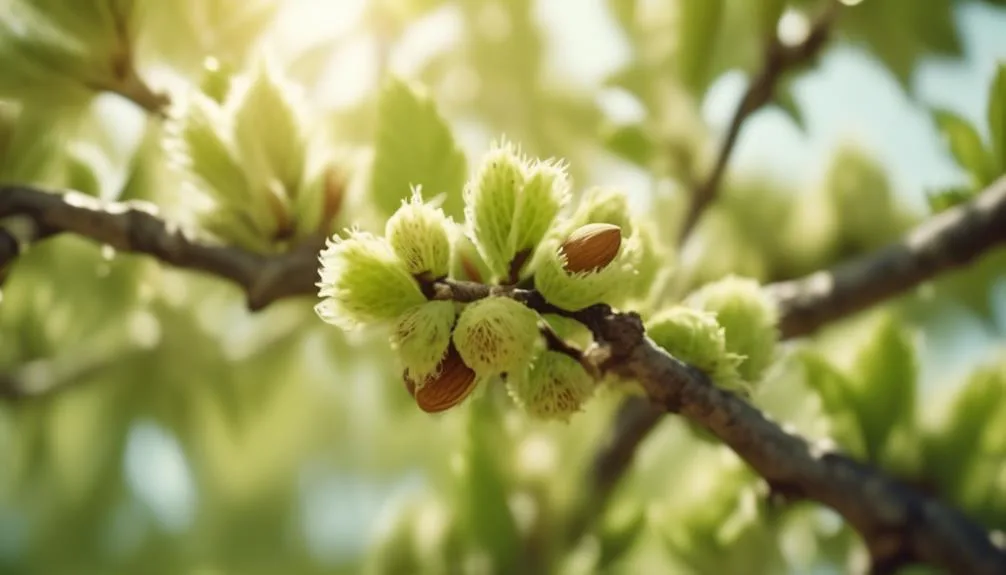If you've noticed your almond trees looking less vibrant, with yellow leaves or wilting branches, they might be suffering from common diseases. But don't worry, there are practical ways to identify, treat, and prevent these issues.
In this discussion, we'll cover simple methods to help you keep your almond trees healthy and productive.
Key Takeaways
- Regularly inspect almond trees for signs of disease or pest infestation
- Implement targeted treatments, such as fungicides and insecticides, for effective disease control
- Use preventative measures like regular pruning, proper sanitation practices, and planting disease-resistant almond tree varieties
- Consider organic treatments, such as neem oil and compost tea, to enhance disease resistance and reduce the need for chemical interventions
Identifying Common Almond Tree Diseases
To identify common almond tree diseases, observe the leaves, branches, and overall health of the tree for any signs of discoloration, spots, or abnormal growth. Early disease identification is crucial for effective treatment. Keep an eye out for symptoms such as yellowing or browning of leaves, powdery mildew, or cankers on branches.
Almond tree pests like aphids, mites, and borers can also contribute to the tree's susceptibility to diseases, so check for their presence as well. Regularly inspect the tree during the growing season and take note of any changes in its appearance. By being proactive in disease identification, you can implement targeted treatments and protect the health of your almond tree.
Preventative Measures for Almond Tree Diseases
Implementing regular pruning and proper sanitation practices can significantly reduce the risk of almond tree diseases.
Consider planting disease-resistant almond tree varieties, such as Nonpareil or Carmel, which are known for their resistance to certain common almond tree diseases.
Additionally, maintaining soil health is crucial for disease prevention. Ensure proper drainage to prevent waterlogging, as excessive moisture can lead to root rot and other fungal diseases. Regularly check for signs of nutrient deficiencies and address them promptly through fertilization. Avoid overwatering, as it can create favorable conditions for disease development.
Chemical Treatments for Almond Tree Diseases
Promoting the overall health and vitality of your almond trees can also involve utilizing chemical treatments to effectively combat common almond tree diseases.
When it comes to pest management, using insecticides can help control harmful pests like aphids, mites, and scale insects. These chemicals work by disrupting the pests' life cycle, reducing their population and minimizing damage to your trees.
Additionally, fungicides are essential for managing fungal infections such as powdery mildew and brown rot. These products help prevent the spread of diseases by inhibiting the growth of fungal spores on the tree's foliage and fruit.
Always follow the instructions on the product label carefully to ensure safe and effective application. Properly timed and targeted chemical treatments can significantly contribute to maintaining the health and productivity of your almond trees.
Organic Treatments for Almond Tree Diseases
Consider utilizing organic treatments to effectively combat common almond tree diseases while promoting the overall health and vitality of your trees. Implementing natural remedies can help enhance disease resistance and reduce the need for chemical interventions. Here are four organic treatments to consider:
- Neem oil: This natural oil acts as a powerful fungicide and insecticide, effectively controlling a wide range of almond tree diseases.
- Compost tea: Rich in beneficial microorganisms, compost tea can boost the tree's immune system and improve overall disease resistance.
- Copper fungicide: This organic solution effectively manages various fungal diseases while being less harmful to beneficial insects and the environment.
- Beneficial insects: Introducing predatory insects like ladybugs and lacewings can help control pests and prevent disease spread in a natural, eco-friendly manner.
Maintenance Tips for Healthy Almond Trees
To maintain healthy almond trees, regularly inspect the foliage and branches for any signs of disease or pest infestation. Pruning techniques are crucial for promoting tree health. Remove dead or diseased branches, and ensure proper air circulation within the canopy. This helps prevent the spread of diseases and encourages new growth.
Additionally, pay attention to soil health. Ensure the soil is well-draining and rich in nutrients. Consider conducting soil tests to assess its pH levels and nutrient content, making amendments as needed. Proper watering and mulching also contribute to soil health and overall tree vigor.
Conclusion
Incorporating regular maintenance, proper watering, and vigilant disease monitoring will keep your almond trees healthy and productive.
By taking proactive steps, whether through chemical or organic treatments, you can ensure a bountiful almond harvest for years to come.
Keep up the good work and enjoy the fruits of your labor with beautiful, thriving almond trees!

